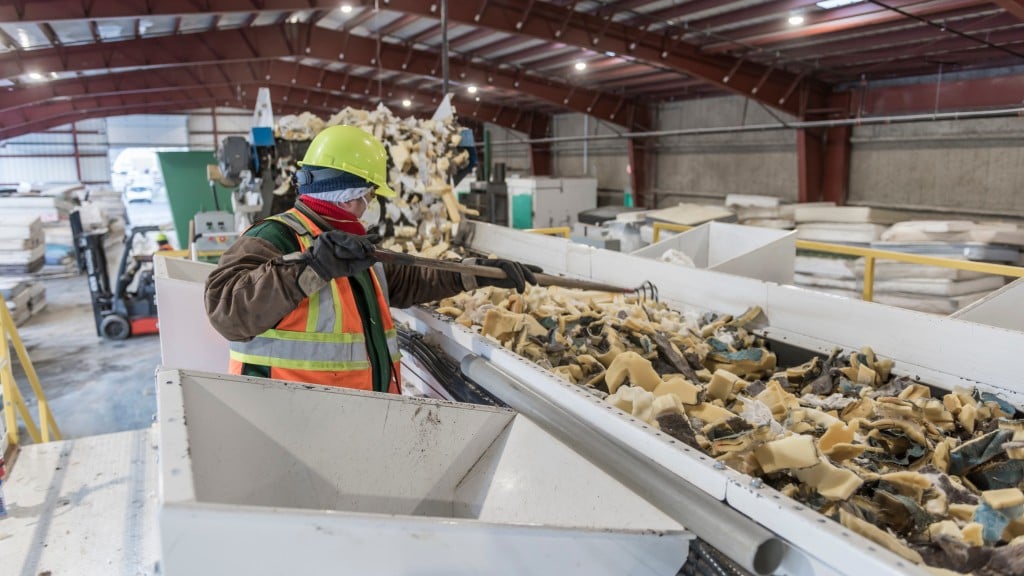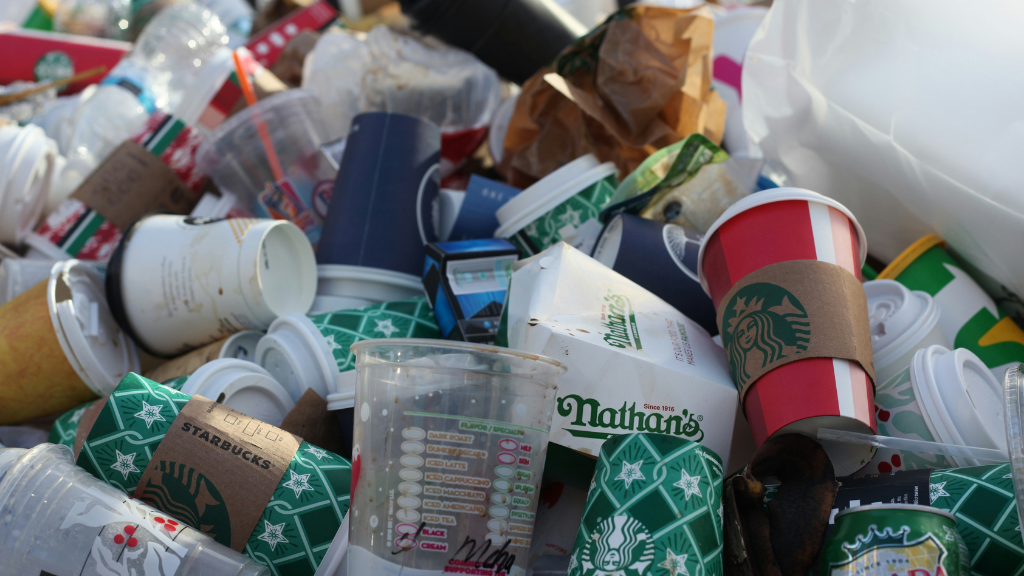Hope for mattress recycling
Pacific Mattress recycling in Hope, B.C., is operating the first automated facility of its kind

Pacific Mattress Recycling Inc. was started by Owner and President Fabio Scaldaferri in Vancouver in 2008 along with three other young entrepreneurs. In 2018, the company, known more commonly as Mattress Recycling, established a new multi-million-dollar facility in Hope, B.C. and is now the largest operation of its kind in Western Canada, a certified living wage employer, and a leader in the automated recovery of used mattresses.
According to Scaldaferri, one of the first tasks they turned their attention to after starting the company was to influence change in regional legislation surrounding the system for managing end-of-life mattresses in B.C.
"We went to Metro Vancouver council meetings and presented the case for a ban on mattresses, box springs and futons from landfill and incineration," he says, and a ban was fast-tracked to start in January 2011. Scaldaferri believes it to be the very first of its kind in the world for such a large region. Currently, most of B.C. is regulated by a similar ban. "Landfills in general dislike mattresses, because they are high volume, low weight," explains Scaldaferri.
"Mattresses are basically bad for the business of running a landfill. They're bad for compaction and tough on equipment. Our solution to recycle them is an easy sell at the landfill because they'd much rather get rid of them."
He says as soon as the landfill ban on mattresses was implemented in Metro Vancouver, the change for their business was significant. "All of a sudden our incoming stream went from about two to three thousand mattresses yearly to 65,000. Over the last decade, in total we've processed more than 750,000 mattresses."
Automation, end markets and diversification
According to Scaldaferri they have created a world-first system for recycling mattresses at the Hope facility with respect to their automated process.
"We've invested in an automated system, which we've developed over many years of trial and error, which has taken our need for warehouse personnel from 45 to 4," he says. "We purchased over three acres of industrial land here and invested in high-quality equipment. We designed a customized system in our building and built our 21,000-square-foot facility specifically for our line and for our purposes with respect to safety and efficient operations."
The Mattress Recycling facility in Hope includes 22 loading bays and one graded drive-in entrance. Scaldaferri says it is also significant that they are located at a junction of five major highways. "We are located in a spot that is much more conducive to efficient, profitable, safe recycling than where we used to be."
He explains that before settling into their location in Hope, they moved their business six times to various leased locations, including the Mitchell Island industrial park and other locations in and around Vancouver, looking for the right fit.
"It's hard to find buildings that are suited to this kind of use," he says, adding that fire is a huge issue in the recycling industry, and that Pacific Mattress Recycling has been forced to rebuild twice due to fire. In their new facility, Scaldaferri has emphatically addressed the issue by building multiple fire-suppression systems into his line.
"We've now invested over two million [dollars] in machinery, systems and technology, from established suppliers and another three million for our facility and property," he says.
In their mattress recycling process, key machinery includes electromagnets, grinders, shredders, screens, conveyors and systems for sorting and picking lines, as well as balers for their end-product - mostly baled plastic polymer. They also run two electric-powered forklifts for moving material around their facility.
"We keep things quite orderly and we're set up for high-volume, consolidated loads. Ideally, we prefer delivery of mattresses in larger loads, using a 53-foot dry van, because it maximizes efficiency and minimizes costs. This is why we have so much room inside our facility and so many bays on our building."
He says once mattresses are loaded into their facility, the first stage is grading by eye to determine the state and exact composition of the mattresses they are dealing with. Mattresses then go through their automated process, by which they are eventually completely deconstructed and baled into saleable commodities.
The main end-market for Mattress Recycling's recovered materials is the domestic flooring industry in North America, where materials such as foam and mattress toppers are used to make new recycled-content flooring and carpet. Steel is also recovered and sent to local facilities for repurposing.
Non-marketable residuals from their process, he says, are sent to the local cement industry to feed their kilns. This provides alternative fuel (coal replacement) for cement companies, and provides Scaldaferri's business with a responsible, sustainable way to deal with the waste material produced from the mattress recycling process.
Beyond mattresses, Scaldaferri's business over the last several years has seen some diversification as they continue to add a variety of end-of-life product categories including shoes, textiles, car seats and plastic film to their list of acceptable items. The facility also accepts major appliances for free as part of the MARR (Major Appliance Recycling Roundtable) program, as well as household packaging such as glass, paper and plastic through Recycle B.C., and actively seeks out community partners for unique projects. Most recently, they processed recycled shoes for a well-known Vancouver shoe brand to create the base for a new playground.
Polymer plastics and the modern mattress
It's a common misconception that mattress-fill and pillow-top material is made mostly out of cotton, or that there are a lot of metal springs in the average mattress. Today's mattresses are made almost entirely out of plastic polymer material, apart from some metal and wood in box springs.
"Modern mattresses don't contain much metal at all," Scaldaferri explains. "Most of them use pocket coils which have a very low amount of metal or steel, and are very difficult to deconstruct by hand. The actual amount of steel in mattresses overall has greatly reduced in the last several decades."He continues, explaining that the modern mattresses' bulk is made of polyurethane foam, which is a petroleum-derived plastic polymer material - plastic. "You don't see cotton downing anymore, unless buying a boutique mattress," he says.
"Mass market mattresses include mostly foam and quilting - which are polyester or nylon engineered textiles and other synthesized fabrics."
He adds that the volumes of different material they recover from mattresses also depends on where a particular load originates. Mattress loads hauled to their facility from landfills, or the relatively small amount dropped off by the public, are a mix of mostly newer foam mattresses and some older styles, including the older metal-spring-based mattresses they see, which is not a great amount overall.
A major source of incoming used mattresses for Pacific Mattress Recycling is from the furniture and hotel industries. Their contract with one global furniture/retail giant, which operates a mattress-return program based out of their outlets near Vancouver, brings in a large amount of mattresses every year, almost entirely foam-polymer based. "Hotels are definitely another huge source of used foam-polymer based mattresses, and they regularly do floor-by-floor switch outs for new mattresses," explains Scaldaferri, adding that hotels are mandated within Metro Vancouver to recycle their mattresses and not landfill or incinerate them. This is similar around most of B.C.
"We just did a back-to-back switch-out (multiple floors) recently with a major hotel in Vancouver, and we picked up about the equivalent of fourteen 53-foot trailers full of mattresses."
Progress on mattress recycling policy
With a near-province-wide regional ban on mattresses to landfill or incineration in place and an established, dedicated, cutting-edge mattress recovery operation such as Pacific Mattress Recycling in Hope, there is no question that B.C. is among global leaders in mattress recycling. In fact, Scaldaferri says, communities across the province have been diverting mattresses from landfill and incineration for many years.
"Many communities in B.C. send mattresses to us voluntarily, with no localized ban in place," he says. "But the ban definitely helped us and has created a unique situation in B.C. It has sparked a trend in the province and is speeding progress on mattress recycling."
He adds that a ban to landfill and incineration is not the only way to make progress on mattress recycling. The other way is Extended Producer Responsibility (EPR). With respect to EPR for mattresses, California, Rhode Island and Connecticut have mattress EPR programs in place, with 14 facilities that recycle mattresses between the three states.
According to Mike O'Donnell, Managing Director of the U.S. based Mattress Recycling Council (MRC), funding for all three programs comes from a fee at point of sale paid by purchasers in those states including individual consumers and large volume buyers like hotels and universities. On-line mattress sales also have the fee applied. Combined, MRC's programs are recycling over 1.5 million mattresses and box springs annually.
In Canada, Scaldaferri says, we don't have any such established mattress EPR, but it has been the topic of a number of recent industry roundtables and he hopes it will be in place soon.
"Unfortunately, we don't have an EPR system yet, but we're advocates for this change," he says. "There needs to be more movement toward both landfill bans and EPR, and regulators in Canada need to move quickly."
Another element required to increase the amount of mattresses being recycled he notes (similar to all recyclable materials) is capital - increased investment in the sector.
"I've been in the recycling industry for more than 10 years now," he continues. "The recycling industry is very under-invested in. It's my biggest frustration with our industry overall. Recycling is top of mind for most Canadians, but where is the capital? There's an ‘impact investing' movement, but I don't feel like it's moving fast enough. The tech sector is the investment darling, and dollars just aren't flowing into recycling."
He continues, "With a company like this, I'm 100 percent owner, and I started it when I was in my 20s and with not a lot of money. We've done well over the years, but we need more capital, we need more investment, more meaningful investment, so that we can strengthen our business - which is an important business for everybody. We're providing a similar service to a transfer station, but without a municipal budget to respond to things like breakdowns.
"In recycling, there's a great deal of burden placed on a low-profit-margin business model. It's not fair to recyclers to be required to effectively subsidize the service we provide. We're certainly always looking for more investment, or even to partner with the right organization to get investment."
In the meantime, Scaldaferri says, Mattress Recycling continues to grow, business is steady and they are proud to be a global pioneer in a sector of the recycling industry that can only move forward from here. RPN
This article was originally published in the November/December 2019 edition of Recycling Product News, Volume 27, Number 8.


